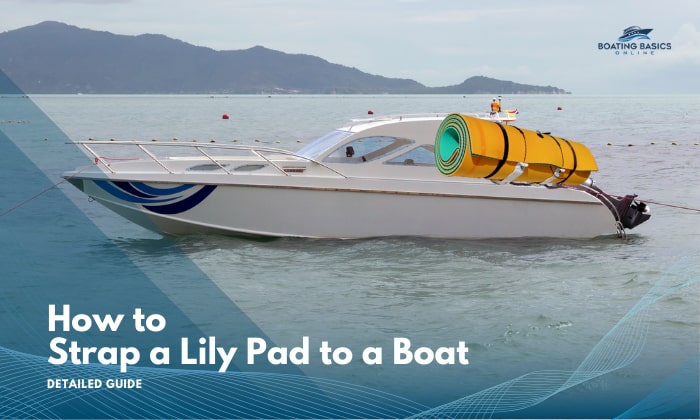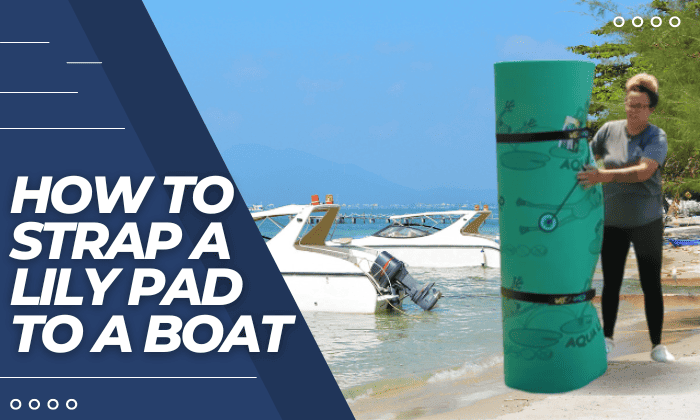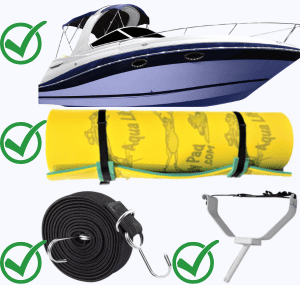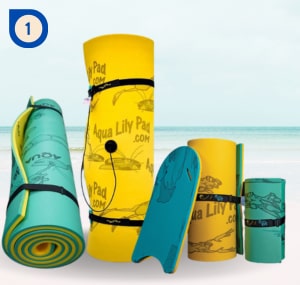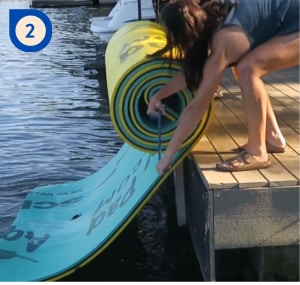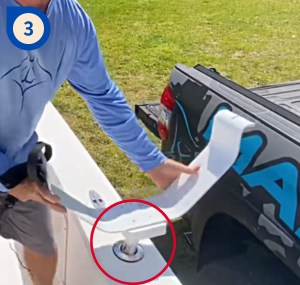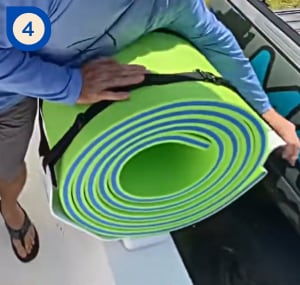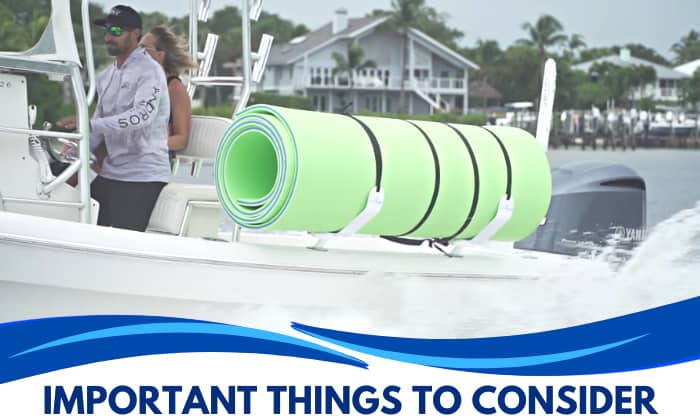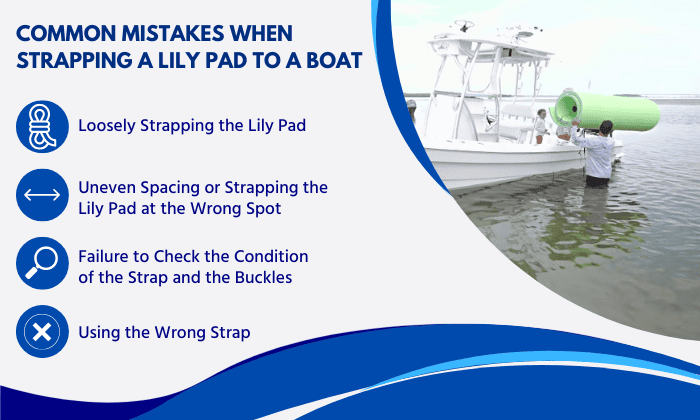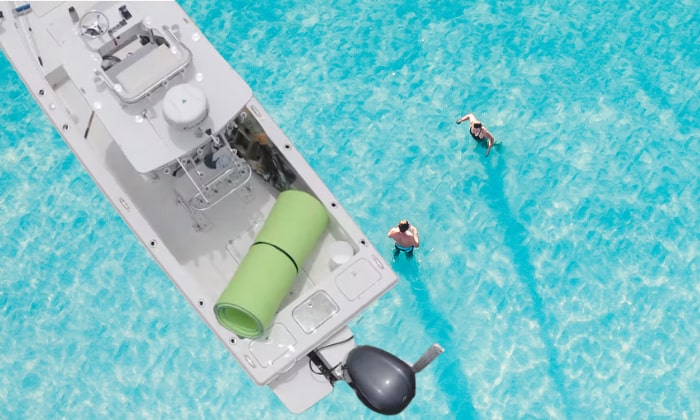Lily pads will double the fun for your family when boating. This floating mat serves as a playground for your kids on the water and provides extra space for you and your family.
The lack of knowledge about how to strap a lily pad to a boat may ruin the fun and result in inconvenience and accidents. It is the goal of this article to provide you with the steps and relevant information to secure a lily pad to a boat.
Table of Contents
4 Simple Steps to Strap a Lily Pad to a Boat
It is not difficult to attach floating mat to a boat. It only involves a few materials and instructions.
What You Need
- Boat
- Lily pad
- Straps or bungee cords
- Lily pad or floating mat holder
Step 1: Purchase your preferred lily pad.
The first step to attach a lily pad to a boat is, of course, to acquire one. You need to decide which type and size of lily pad to get. A lily pad can accommodate 6 to 12 persons, depending on the size and number of layers.
Step 2: Dampen the lily pad.
This step ensures that the lily pad sticks to the boat during transport. This step assumes that the lily pad is already rolled up. It should not be challenging to roll up a lily pad; just keep your weight on one side of the mat as you fold it.
Step 3: Find the perfect spot to strap the lily pad.
A lily pad is an investment. You don’t want it to drift away because you did not put or attach it properly in the right place. Lily pads are typically placed at the back of a boat.
A lily pad holder for boat may be useful if you have money to spare. This accessory has a mount that attaches to the boat’s tow bar, where you can secure and place your mat. You can use it to transport lily pad on pontoon if you know your tow bar tube diameter.
Step 4: Secure the lily pad.
In strapping the lily pad to the boat, you need to ensure that you do not damage the item or the boat. Lily pads usually come with a bungee cord. However, if it does not have one, you can use Velcro or zip ties.
When the lily pad is positioned at the back of the boat, fasten your strap or rope around it then run the line through handles, cleats, or whatever attachment points strong enough to keep the pad from moving.
Important Things to Consider
- Double-check that the lily pad on the fishing boat is secure before docking away. This final check is critical to avoid unnecessary hassles on the water.
- The best way to strap a lily pad to a boat is to use as many ropes or buckles as necessary, especially if the pad is big.
- To prolong the life of your lily pad, always ensure that you follow the usage guidelines as stated in the manual.
- There can be a number of storage ideas for storing lily pad, but the best way to hold your investment is to use a lily pad storage bag. It is best to keep this item in a cool and dry place.
- Proper care is also important to prolong the life of your lily pad. Ensure to rinse it after every use to avoid the growth of mold and mildew.
Common Mistakes When Strapping a Lily Pad to a Boat
Below are some of the common mistakes when strapping a lily pad to a boat. Take a look at these mistakes to ensure that you avoid them.
- Loosely Strapping the Lily Pad
Being complacent is dangerous. When strapping your lily pad to your boat, you need to ensure that the strap is secure and not loose. It should be long enough to cover the length or circumference of the mat.
- Uneven Spacing or Strapping the Lily Pad at the Wrong Spot
You need to ensure that you space the lily pad evenly. Lily pads can be a little heavy and could cause the boat to lose balance. The back of the boat is the best place to strap the lily pad.
- Using the Wrong Strap
Using the wrong strap or rope can damage the lily pad flotation device. Ensure to use the bungee cord that comes with the pad or Velcro or tie-down straps with high tensile strength.
- Failure to Check the Condition of the Strap and the Buckles
It is critical that you check the condition of the straps and buckles to ensure that they don’t have wear or damage. The last thing you want is to see your lily pad drifting away because the strap or the buckle failed.
Frequently Asked Questions
What do you do after strapping a lily pad to a boat?
After strapping your lily pad to your boat, you can check the tightness of the strap after a certain period to ensure that it is still securing the lily pad. The strap can become a little loose as you navigate the waters.
Adjust the tightness as necessary. Keeping the lily pad wet can also help it stick more to the boat.
It is also advisable to clean the mat after use and dry it before storing.
What are the different types of lily pads for boats?
There are many types of water pad for boat you can consider getting. Among them are foamy lily pads, rubber lily pads, sowkt lily pads, and maui lily pads. Each type of lily pad has its own advantages. Foam is lighter than rubber, for instance, but rubber is more durable.
Can you anchor a lily pad?
You can definitely anchor a lily pad! You can tie it to a dock or another object in the water. Many manufacturers actually offer anchoring devices in their packages.
Can you pull a lily pad behind a boat?
Lily pads are not designed to be pulled or towed. The surf and water pressure may break the strap and the material.
Conclusion
Understanding how to strap a lily pad to a boat is not difficult. There are only a few steps you need to take.
You must find the best spot to strap the rolled up lily pad. The best way is to strap it at the back of the boat or on a holder system. You also need to ensure that you balance its weight so that it will not affect the balance of the vessel.
Then, strap or secure the pad using a bungee cord or a Velcro strap to ensure that it is not damaged during transport

“My intention from the first day establishing Boating Basics Online is to provide as much help as possible for boaters who want to experience a first safe and convenient trip. So feel free to join us and share your beautiful journeys to the sea!”

